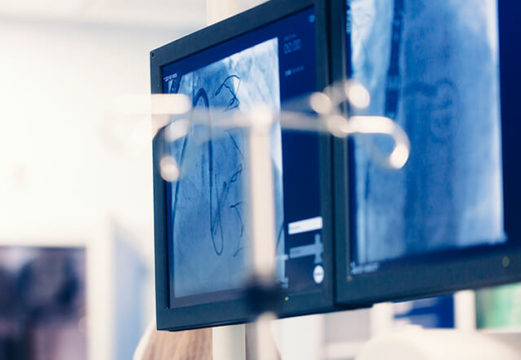Second and third generation drug eluting stents (DES) have thin or ultrathin struts and a scaffold that has evolved over time, which offers great release capacity and radial strength, with low thrombosis and restenosis rates. Even though their expansion capacity and radial strength have been studied thoroughly, we know little about the longitudinal mechanical properties of these stents.

There is generalized belief that stents shorten during overexpansion and POT (proximal optimization technique), but in silico and in vivo analysis have shown the opposite: stent elongation. This phenomenon might have significant repercussions, such as stent ostial protrusion, unintended side-branch overlap, malapposition and proximal underexpansion, which will increase the risk of stent failure.
Even though we are aware of the interaction between plaque morphology and radial expansion, the impact on stent longitude remains unclear. This is why McGarvey et al., from King’s College London, carried out an OCT study (optimal coherence tomography) to assess the relationship between plaque morphology and stent longitudinal behavior.
Data form the KODAC registry and a retrospective OCT study from King’s College London were gathered, including patients with de-novo bifurcation lesions (LM or LAD/Dx) treated with second or third generation DES. It excluded patients with prior percutaneous coronary intervention (PCI) to the area of interest, poor imaging, or stent overlap in the main vessel.
Read also: Impact of Iliofemoral Disease on Post TAVR Clinical Outcomes: HOSTILE Score Validation.
OCT was done and lesions were categorized into fibrocalcic, fibrous or lipid-rich. Proximal and distal expansion were assessed following ILUMIEN IV criteria, dividing stents into two virtual segments and calculating minimal stent area (MSA) at proximal and distal level. Finally, stent expansion index was calculated (SEI) vs reference vessel.
The primary outcome was the percentage change in stent longitude from baseline to post dilation and POT.
Between July 2017 and March 2022, 501 OCT guided PCI were carried out, according to the KODAC registry, 116 of which were eligible for this study. Mean patient age was 66, and 31% were women. 53.4% of patients were treated for acute coronary syndrome (ACS), 33% were diabetic and 5.3% had chronic kidney failure. 50% of lesions studied were fibrocalcic, 6.9% fibrous and 43.1% lipid-rich.
Patients with fibrocalcic lesions were older with more hypercholesterolemia and diabetes. 57.8% of lesions affected the anterior descending and first diagonal, 26.7% were true bifurcations (Medina 111, 101 and 011). The everolimus eluting XIENCE stents were used in most cases, with 28 mm length and 3.0 mm diameter, and 117% mean POT overexpansion.
Post PCI OCT analysis showed 4.4% relative stent elongation, with significant increase after implantation and postdilation, going from mean nominal longitude 28.0 mm to 31.1 mm (IQR 23.9-38.2; p<0.001). Elongation varied significantly according to plaque morphology, with 3.1% for fibrocalcic lesions, 6.4% in lipid-rich lesions and 3.3% in fibrous lesions. There were no significant lesions in stent expansion relative to plaque morphology, with similar SEI values.
Conclusions
McGarvey et al’s analysis is the largest in vivo OCT study on stent longitude assessment. Mean stent elongation of 4.4% was observed in all lesions, which represents mean 1.3 mm increase. Lipid rich plaque showed the largest relative increase (6.4%), which suggests this factor must be considered during precision PCI to prevent complications.
Original Title: Impact of lesion morphology on stent elongation during bifurcation PCI: an in vivo OCT study.
Reference: McGarvey M, Lam LT, Razak MA, Barraclough J, O’Gallagher K, Webb I, Melikian N, Kalra S, MacCarthy P, Shah AM, Hill JM, Johnson TW, Byrne J, Dworakowski R, Pareek N. Impact of lesion morphology on stent elongation during bifurcation PCI: an in vivo OCT study. EuroIntervention. 2024 Sep 16;20(18):e1184-e1194. doi: 10.4244/EIJ-D-23-00663. PMID: 39279513; PMCID: PMC11384226.
Subscribe to our weekly newsletter
Get the latest scientific articles on interventional cardiology





